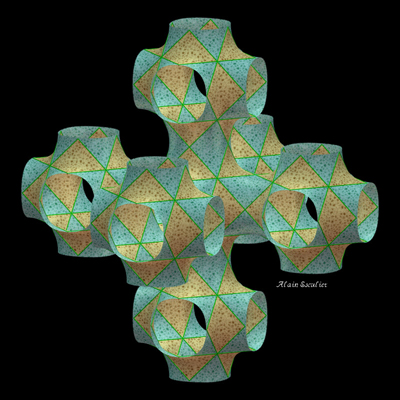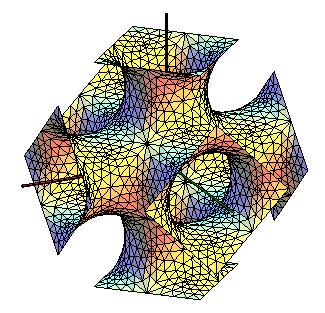SCHWARZ "D" AND "P" MINIMAL SURFACES


| next surface | previous surface | 2D curves | 3D curves | surfaces | fractals | polyhedra |
SCHWARZ "D" AND "P" MINIMAL SURFACES


| Surfaces studied by Schwarz in 1864, then by A.
H. Schoen in 1970, who gave the abbreviations "P" and "D".
Hermann Amandus Schwarz (1843-1921): German mathematician. Websites: Wikipedia Povray views of this page made by Alain Esculier |
| The Schwarz "D" (for diamond) minimal surface is the
triply periodic minimal surface
the fundamental patch of which is the solution of the Plateau
problem for a contour that is one of the 6 skew quadrilaterals made
from a skew hexagon inscribed in the edges of a cube, as represented opposite.
The Schwarz "P" (for primitive) minimal surface is the surface built similarly to the previous one from a skew hexagon this time inscribed in the edges of a regular octahedron. |
 Skew hexagon, base of the Schwarz D surface, composed of 6 skew quadrilaterals; the yellow edges are 6 of the 12 edges of a cube. Each Plateau quadrilateral has 3 right angles, an angle of 60°, and two sides equal to sqrt(2) times the other two. |
 |
| The Plateau solution for a skew quadrilateral is not,
like it could be hastily thought, a portion of hyperbolic
paraboloid (HP) the generatrices of which are its sides, and one will
find, here
for Schwarz D, and here
for Schwarz P, the exact calculation of this solution (and one will find
in these articles that the two surfaces are conjugated by the Bonnet transform):
the
Weierstrass
parametrization is obtained with In the opposite views of the 6 surfaces supported on the 6 skew quadrilaterals, we used a triangulation method that provides a surface supported on the considered contour, but which is not the Plateau surface; the method is detailed at the bottom of this page. |

Base hexagon for Schwarz D |

|
| The complete Schwarz D surface is obtained by applying the 6 symmetries with respect to the 6 sides of the base hexagon and iterating to infinity. |
 |
 |
| Ditto for the P surface. |
 |
 |
| The complete P surface can be seen as a network of pipes crossing at right angles (hence the nickname of "plumber's nightmare"). |  |
 By replacing the Plateau quadrilaterals by portions of hyperbolic paraboloids, we get the sculpture by Angel Duarte in Lausanne. |
|
If half of the 24 quadrilaterals of the previous pattern are carved out, we get a pattern that generates the entire surface by translations. |
 |
This concrete construction shows how the complete sphere
is built based on the previous pattern, and also shows that the surface
splits the space into two connected parts that can be superimposed (the
inside of the pipes is isometric to the outside).
 |
 |
| The complete D surface can be seen as a network of pipes
crossing at angles of 109°28', like the segments joining the center
of a regular tetrahedron to the 4 vertices.
Here also, the inside and the outside of the pipes can be superimposed. |
 |
 |
| Another way of constructing the final D surface is to begin by making this saddle composed of 4 base hexagons, and then to duplicate it by translations: |
 |
 |
| The D and P surfaces can be approximated by so-called
"nodal" surface with respective Cartesian equations: |

Approximate D surface res:=90:maxi:=5*Pi/2:f:=(x,y,z)->if x+y+z<maxi and x-y-z<maxi and -x+y-z<maxi and -x-y+z <maxi then cos(x)*cos(y)*cos(z) -sin(x)*sin(y)*sin(z) else NULL fi: implicitplot3d( 'f'(x,y,z), x=-maxi..maxi ,y=-maxi..maxi, z=-maxi..maxi,grid=[res,res,res],style=patchnogrid,lightmodel=light2,scaling=constrained,orientation=[140,25]); |
Explanation of the process of triangulation above, not on a quadrilateral,
but directly on the skew hexagon of the D surface:
We start from the 6 triangles delimited by the 3 diagonals of the contour;
then for each triangle, define 3 points "corresponding" a bit to each middle
of the sides, with 2 cases:
If the side is on the contour: then the point really is the middle
of this side.
If the side is not on the contour: then the point is the barycenter
of the vertices of the faces that have this side in common (therefore the
ends of the common side count twice).
The triangle is then split into 4 smaller triangles, the vertices of
which are those of the initial triangle plus the 3 points defined.
Here are the 5 first steps of this process, the fifth traced without
the triangles:
 |
 |
 |
 |
 |
 |
See also the Neovius surface and the gyroid, minimal surfaces that have the same Weierstrass representation as the D and P surfaces, but another Bonnet angle.
|
Schwarz D |
Schwarz P |
Engravings of Schwarz surfaces with asymptotic and curvature lines, by Patrice Jeener, with his kind authorization.
| next surface | previous surface | 2D curves | 3D curves | surfaces | fractals | polyhedra |
© Robert FERRÉOL Alain ESCULIER 2017